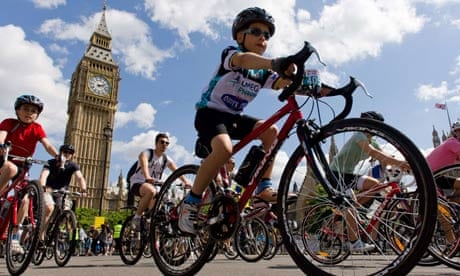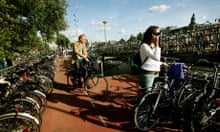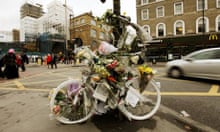Yes, £77m, the largest ever investment in cycling, is a welcome boost for England's cyclists. So too – and this is almost the more significant factor – is David Cameron's decision to front the announcement himself, rather than, as usual, leave it to his harried and sometimes isolated cycling minister, Norman Baker.
And in some places, notably Manchester, West Yorkshire and Birmingham, which get the bulk of the money, life will certainly improve for some cyclists on some routes. All well and good.
But is this, as Cameron insisted alongside Sir Chris Hoy, the start of "a cycling revolution"? Not really.
For all Britain's cycling success in the Olympic velodrome and Tour de France, the country is a long, long way from being a nation of cyclists. The proportion of journeys made annually by bike, at around 2%, puts the UK near the bottom of the EU tables.
Today's announcement makes great play of the fact that some of the areas targeted by the £77m extra money will now see up to £10 per head of population spent on cycling in a year. Again, that's better than before. But to get a significant increase in bike use, the transport planners generally agree, requires somewhere nearer £20 per person per year, every year. It requires a commitment over decades – the sort of commitment needed for projects like Crossrail (for which £80m would barely fund a mile of track).
The curious thing about debates connected to cycling in Britain is that there is near political consensus now on two key areas: more people on bikes is a good thing; and we know how to achieve it. Study after study shows that people ride bikes if they feel safe, and they tend to only feel safe if they have access to continuous, well-designed, dedicated cycling infrastructure, including (where needed) segregated bike lanes, and redesigned roundabouts and junctions.
This requires not only money but political leadership, especially in a nation where the motoring lobby remains strong.
Thus far, the only person to have outlined a vision that goes somewhat ahead of public opinion, rather than just following it, is London mayor, Boris Johnson. Though still viewed with suspicion by many of the capital's cyclists, in March he set out an ambitious plan to double cycling levels by 2020 with a plan costing not £77m but £900m. For one city. That's the sort of ambition required.
Could it be matched nationwide? The signs are not promising. When MPs return from their recess they will debate a report published in April by an all-party parliamentary group which urged the government to invest at least £1bn a year on cycling, every year, for decades. Only then would cycling levels rise significantly, they argued.
Despite the heroic efforts of MPs involved in the report, as well as pressure groups and the Times newspaper, the response so far from the Department for Transport has been polite disinterest. Cameron's interest in the subject was arguably illustrated when the committee heard evidence from Baker, the junior transport minister who conceded that he had never once discussed his cycling portfolio with the prime minister.
Some might argue that a demand for £1bn a year in spending is absurd in such straitened times. Yet it is worth noting that Cameron's launch of the £77m funding comes on the same day that the British Heart Foundation warned a lack of exercise by children will cause many of them health problems in later life. This is a nation where only an estimated 3% of secondary pupils ride to school. In Copenhagen it's about two-thirds.
A government report from 2004 estimated the total cost of physical inactivity in England alone to be around £8.2bn a year. Suddenly £1bn doesn't sound like such a lot.











Comments (…)
Sign in or create your Guardian account to join the discussion